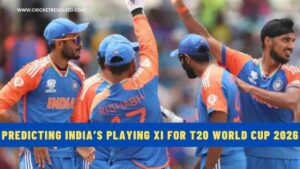The Ranji Trophy tournament is the pinnacle of the Indian domestic cricket structure. The premier First-Class competition takes place every year.
Since its inception in 1934, many domestic teams from across the country have participated in the Ranji Trophy to get their hands on the silverware. Over the years, the tournament has undergone many changes, with its format being the most prominent one.
So, in this article, we’ll see how the Ranji Trophy’s format has evolved with time.
But, before we delve deeper, let’s see the number of teams that partake in the competition.
How Many Teams Participate in the Ranji Trophy?
As of now, a total of 38 regional teams participate in the Ranji Trophy. All 28 states in India have at least one team, with Maharashtra (Maharashtra, Mumbai, and Vidarbha) and Gujarat (Gujarat, Baroda, and Saurashtra) having 3 each.
Moreover, teams from 4 union territories also play in the tournament, along with 2 pan-India teams — Railways and Services.
Current Ranji Trophy Teams:
Andhra Pradesh, Arunachal Pradesh, Assam, Baroda, Bengal, Bihar, Chandigarh, Chhattisgarh, Delhi, Goa, Gujarat, Haryana, Himachal Pradesh, Jammu & Kashmir, Jharkhand, Karnataka, Kerala, Madhya Pradesh, Maharashtra, Manipur, Meghalaya, Mizoram, Mumbai, Nagaland, Odisha, Pondicherry, Punjab, Railways, Rajasthan, Saurashtra, Services, Sikkim, Tamil Nadu, Hyderabad, Tripura, Uttar Pradesh, Uttarakhand, Vidarbha
Now, all these teams have not been playing since the championship’s first season. A few joined the bandwagon after independence, while others have been there since the pre-independence era.
Furthermore, some teams appeared in the past, but they no longer play in the tournament. Some teams were part of pre-partitioned India, while others were either merged or disbanded after their states got reorganised post-independence.
Defunct Ranji Trophy Teams:
Central India, Central Provinces and Berar, Northern India, Sind, Southern Punjab, Western India, Nawanagar, North West Frontier Province, Holkar, Gwalior, Patiala, Eastern Punjab, Travancore-Cochin, Madhya Bharat, Northern Punjab
Some of you may not have even read these names before this!
Now, let’s move on to the tournament’s format structure.
Also Read | The Evolution of Indian Cricket: From Colonial Era to Independence
The Evolution of Ranji Trophy Tournament Format
For a long time, the BCCI organised the tournament based on zones, with teams grouped according to their geographical location. This zonal format was in use from the inaugural season until the 2001-02 season, with teams split across 5 zones — North, East, West, South, and Central.
Later, from the 2002-03 season, the board introduced a new 2-division structure — Elite Group and Plate Group. Both groups had 2 sub-groups, with each team playing in a single round-robin format.
The top 2 teams from each Elite sub-group made it to the knockouts, with the bottom team from each Elite sub-group relegated to the Plate Group. While the finalists of the Plate Division got promoted to the Elite Division.
After 4 seasons, the divisions were renamed the Super League and the Plate League, with teams from both divisions having a chance to claim the coveted trophy. The format continued for almost 10 seasons, with slight changes here and there.
The 2017-18 season witnessed the BCCI adopt a 4 group system, with each consisting of 7 teams. The top 2 teams from each group entered the knockout stage, which included quarter-finals, semi-finals, and the final.
From the next season, a new 3-tier structure was brought in, with the top tier made of Elite Group A and Group B, followed by Group C (second tier), and the Plate Group (lower tier).
Also Read | Difference between First-Class Cricket & List-A Cricket
Current Ranji Trophy Tournament Format
Since the 2022-23 season, the tournament structure has seen a complete change, with the BCCI going back to the 2 division system — Elite Group and Plate Group. However, in this format, 2 winners will be adjudged from both divisions.
Elite Group
The Elite Group will consist of 32 teams split into 4 groups of 8 teams each. In the league stage, each team will play against each other in a single round-robin format.
The top 2 teams from each Elite Group will move on to the quarterfinals. Then the winners of the quarterfinals will meet in the 2 semi-finals. The winners of the semi-finals will then play in the summit clash to win the Ranji Trophy.
The bottom 2 teams on the points table across the 4 Elite Groups will be relegated to the Plate Group for the next season.
Plate Group
On the other hand, the Plate Group will have a solitary group of 6 teams. Each team will play against the other once in the league stage.
Then the top 4 teams will qualify for the Plate Group semi-finals. The winners of the semi-finals will face off in the Plate Group final to claim the Ranji Trophy Plate Group title.
Apart from entering the summit clash, both the Plate Group finalists will get promoted to the Elite Group for the following season.
What is the Ranji Trophy Points System?
The points system is similar across both divisions. When a team wins a match in the league stage, they secure 6 points. There is also a provision for a bonus point if a team wins the match by an innings or 10 wickets, making it 7 points.
If a match ends in a draw, then the team with the first innings lead bags 3 points, while the other side gets 1 point.
In the case of a tie after the completion of both innings, both teams will share 3 points each.
Here’s the Ranji Trophy points structure:
| Result | Points |
|---|---|
| Outright Win | 6 |
| Win by an innings or 10 wickets | 1 (bonus) + 6 = 7 |
| Draw (first innings lead) | 3 |
| Tie | 3 |
| No Result | 1 |
| Loss on first innings lead | 1 |
| Outright Loss | 0 |








